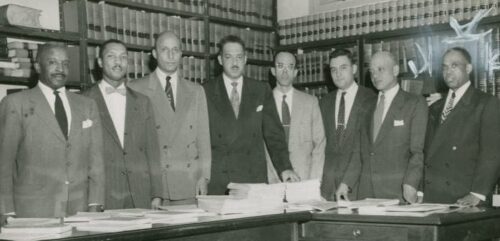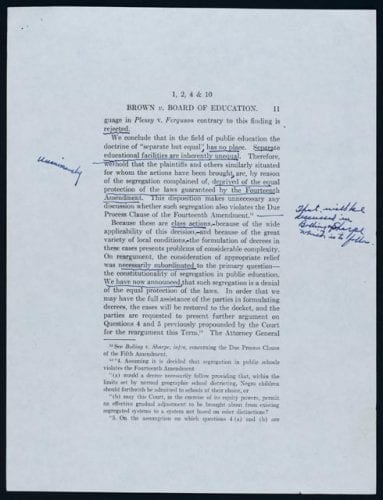
Segregated Public Schools Declared “Inherently Unequal”: Brown v. Board of Education
Today marks the 65th anniversary of a landmark Supreme Court decision mandating racial desegregation in public schools. Issued on May 17, 1954, the first of two decisions in Brown v. Board of Education of Topeka, Kansas unanimously declared segregated public schools “inherently unequal” and held they denied African American children their right to an adequate education.
But why did the Court, led by Chief Justice Earl Warren, feel the need to use the phrase “inherently unequal”?
The answer lies in the terms used to justify legal segregation in the Court’s 1896 decision in Plessy v. Ferguson, which held that racially segregated public accommodations did not necessarily violate the letter or spirit of the Thirteenth Amendment outlawing slavery or the Fourteenth Amendment granting equal protection under the laws. In other words, if the segregated facilities (in this case, rail cars) were equally commodious, the Court majority in Plessy declared that the separation of the races for the social end of “public order” was constitutionally permissible.
To the lone dissenter in Plessy, Justice John Marshall Harlan, the claim that segregated facilities might be equal missed the point. Segregated railway cars were not created to keep white people from choosing to sit with black people, he observed; they were created to bar blacks from choosing to sit with whites. Hence, restricting black people to segregated facilities amounted to imprinting them with “badges of slavery or servitude,” symbolically replicating what the Thirteenth Amendment had abolished. It violated the Fourteenth Amendment by interfering “with the personal freedom” of black citizens to move about as they chose. Segregation violated what Harlan saw as the “color-blind” character of the Constitution, which “neither knows nor tolerates classes among citizens.”
The Precedent Set by Plessy
Despite Harlan, Plessy established a precedent, narrowing the target of legal challenges to segregated facilities that would follow. For example, during the 1930s and 1940s, the NAACP legal team successfully challenged the admissions policies of all-white post-graduate and professional schools by showing that equivalent schools for black students did not exist. These successes, combined with hope triggered by other events, such as President Truman’s 1948 decision to integrate the armed forces, persuaded the NAACP to organize a more fundamental challenge to segregation laws.
The suit brought by Oliver Brown on behalf of his daughter Linda, who was denied admission to an all-white school nearer her home than the black school to which she was assigned in Topeka, was argued collectively with other suits arising in South Carolina, Virginia, and Delaware. But whereas the plaintiffs in the other suits had argued in the lower courts that the schools provided for black children were grossly inferior to those provided for white children in the same communities, the lawyers in Brown decided to challenge the presumption that “separate but equal” schools were even possible. Led by recently appointed Chief Justice Earl Warren, the Supreme Court chose to use Brown as an opportunity to signal to the American public the need for a more robust application of the principle of equality on racial issues.
Chief Justice Warren’s Leadership
Warren worked tirelessly behind the scenes to ensure that the Court’s opinion was both unified and clear enough to be well understood by the general public. In the end, the Court issued two parallel opinions (one to be applied to the states, and one to the District of Columbia), each bluntly stating that segregation of the races was both intended to, and did in fact, create a sense of inequality between the races, and thus was an unconstitutional violation of the Fourteenth Amendment.
To separate [children] from others of similar age and qualifications solely because of their race generates a feeling of inferiority as to their status in the community that may affect their hearts and minds in a way unlikely ever to be undone. …The impact is greater when it has the sanction of the law, for the policy of separating the races is usually interpreted as denoting the inferiority of the negro group. …We conclude that, in the field of public education, the doctrine of “separate but equal” has no place. Separate educational facilities are inherently unequal. Therefore, we hold that the plaintiffs and others similarly situated for whom the actions have been brought are, by reason of the segregation complained of, deprived of the equal protection of the laws guaranteed by the Fourteenth Amendment.
Chief Justice Earl Warren, for the majority in Brown v. Board of Education

Although Warren emphasized the unanimity of the Court as essential to the success of the case, even inserting the word “unanimously” into the oral delivery of the opinion, among his fellow justices, he received significant credit for having orchestrated the outcome. Justice Harold Burton wrote to Warren congratulating him for bringing about “a great day for America and its court… I expect there will be no more significant decision made during our service on the Court.” Likewise, Justice Felix Frankfurter wrote “This is a day that will live in glory… not in the least for the course of deliberation which brought about the result.”
Scholarly Assessments of Brown
Ultimately the decision in Brown expressed the Court’s conviction that the time had come to guarantee equal access to primary and secondary education, called by Warren “perhaps the most important function of state and local governments” because it not only prepares young people for professional success but also for responsible citizenship. Warren’s opinion, although couched in terms of the violation of the principle of equality between citizens enshrined in the Fourteenth Amendment, based that violation on evidence provided by the NAACP of the psychological effect of segregated facilities, not on their existence as a matter of principle per se.
Thurgood Marshall, head of the NAACP legal team and lead counsel for Oliver Brown, based his argument on sociological studies purporting to show the psychological damage suffered by black children living in a segregated society. In the key study, led by Kenneth and Mamie Clark, black children were asked whether they preferred a black or white doll; the majority preferred the white doll. Instead of showing that segregation insulted the dignity and equality of black children—which would have been Harlan’s view—the study purported to show that black children internalized the negative image segregation imposed on them. Warren, writing the opinion of the court, cited the Clarks’ study along with others making similar claims. He also quoted a lower court judge who remarked, “A sense of inferiority affects the motivation of a child to learn.”
Some scholars have called the Court’s ruling in Brown a good decision made for bad reasons. They have questioned the research methods of the Clarks. Others have criticized Marshall’s legal strategy and the Court’s decision for implying that the African American experience of discrimination rendered the myth of racial inferiority a fact. Still others wonder why Marshall did not (as Harlan had) appeal to a claim about the color-blind nature of the Constitution, or reference the numerous instances of poorly funded schools for black children to demonstrate the tendency of the majority group to neglect the educational needs of the minority. But as Professors Emily Hess and Jason Stevens discussed in our 2016 webinar on the case, Warren’s spare and yet sweeping opinion paved the way for the Civil Rights Act of 1964 that outlawed segregation in other public accommodations, discrimination in hiring, racially motivated restrictions on voting, and other Jim Crow statutes.
A future blog post will discuss the “Ruling on Relief,” issued on May 31, 1955 which provided guidance to the states on how to implement Brown. We’ll also discuss the desegregation process that followed.



